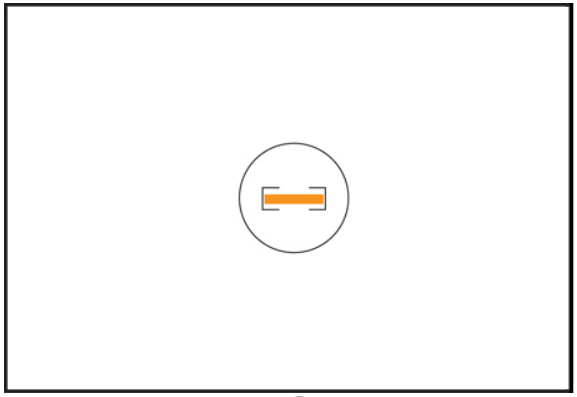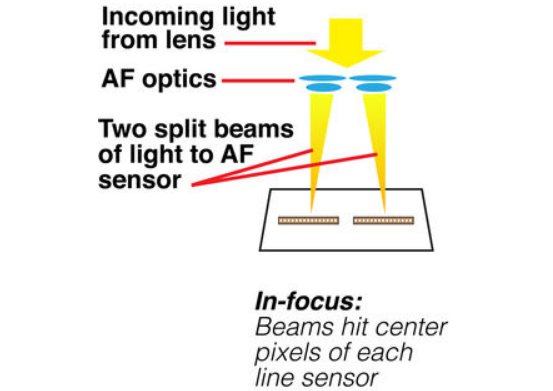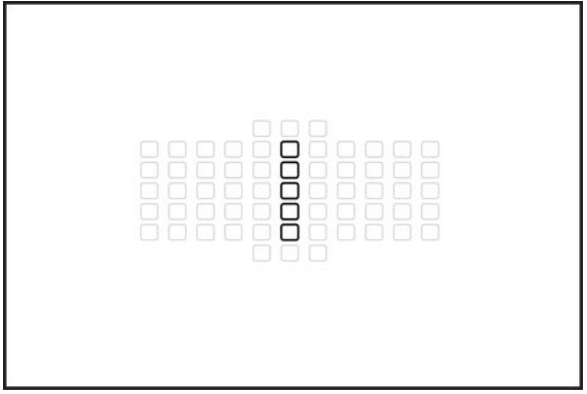EOS-1D X and EOS 5D Mark III "High-precision" and cross-type AF points
| Article ID: ART170242 | | | Date published: 05/03/2018 | | | Date last updated: 05/03/2018 |
Description
Solution
| EOS-1D X and EOS 5D Mark III "High-precision" and cross-type AF points One of the important design goals for Canon’s engineers in developing the new 61-point High Density Reticular AF system in the EOS 5D Mark III and EOS-1D X was to truly optimize the performance of each point on the autofocus sensor. It’s easy to toss around terms, but if a photographer is not clear on what they mean, they may miss out on a lot more than a marketing pitch. Knowing the characteristics of the AF array in these cameras puts the photographer in the position to get the most out of the AF system. |
|
| Cross-type AF points: what are they? Certainly a fair question. And all the more so, because it's not something the photographer can see just looking through the viewfinder. Perhaps the easiest way to answer it is to take a trip down memory lane in AF SLR design. |
|
 |
When the first AF SLRs (35mm film cameras, such as the first Canon EOS 650 and 620 models of 1987) were introduced, they used only a single AF point, located in the center of the picture area. A thin, horizontally-arranged rectangle was etched on the focus screen, indicating roughly the focusing area. These first-generation AF cameras not only were limited to one AF point, but this AF point had only a single line sensor (actually, a pair of line sensors), running horizontally. Again, you can't see the actual AF line-sensors. But they most assuredly see your subject. |
| Because of the way "Phase Detection" AF technology works, there's a fundamental limit to what a single line sensor can read. Detail or contrast running perpendicular to the AF sensor can be read and focused upon nearly instantly, as long as there's enough light. So that single AF sensor in an EOS 650 would work great if focused on something that had essentially vertical detail, like the vertical edge of a window frame or door frame. | |
| However, line sensors are almost blind to detail that runs parallel to them. Point that single-line sensor at something like venetian blinds, and the camera may hunt back and forth, even if the lighting is excellent. For technical reasons, AF sensors have difficulty reading any detail that's essentially parallel to the way the sensor is laid-out. | |
 |
As AF systems developed from the late 1980s, engineers realized that better AF performance was needed. And one way to achieve it was to add another pair of line sensors to the AF sensor itself, and arrange them so that they were 90° from the original horizontal pair of sensors. Doing so, you now had a "cross" arrangement in the center of the picture area. And the benefit was that if a subject (like the aforementioned venetian blinds) was being photographed, if one pair of sensors (the horizontal ones) couldn't read the detail, there was a better-than-good chance that the second pair of sensors could. The "cross-type" AF sensor was born. |
| "High Precision" AF sensors Here's another term that may seem a bit tough to understand. After all, in a high-end pro camera body, aren't all the AF points sufficiently "precise" and accurate? |
|
| Not all AF sensors and the individual AF points on them are created equal. Without getting deeply into the technology behind our phase-detection AF systems, here are the key points to try to envision: | |
 |
|
|
|
 |
|
|
|
|
|
 |
Where does the term "high precision" come into play? The farther apart the two rows of pixels are, the more finely the system can adjust the focus, and the more accuracy it can apply to determining whether focus is "close" or "dead-on". Slight deviations in where the twin beams are focused, if they are off-center, now can be measured in finer increments. Canon EOS SLRs with high-precision AF sensors simply move the pairs of sensors much farther apart, and accordingly, the AF information can be more finely broken-down and reacted to. So why not simply move all the line sensors farther apart? There's a limit, and that is the widest aperture of the lenses a shooter might use. To adequately cover the entire AF sensor array, every AF sensor requires lenses (or a lens + tele extender combination) that's a certain f/stop or wider in order to assure proper AF operation. Standard-precision AF sensors, positioned relatively closely, can get by with lenses f/5.6 or faster. This is an advantage in some ways, because nearly all AF lenses can be used without limitations. |
| But high-precision AF sensors have traditionally required lenses with f/2.8 or faster apertures, since each high-precision AF line pair is farther apart, and requires a physically larger "cone of light" coming into the AF system to fully cover the rows of pixels. When a lens slower than f/2.8 is used, those line pairs no longer function, and (usually) the camera reverts to another pair of standard-precision AF sensors. But high-precision AF sensors provide from 2x to 3x the AF accuracy at the sensor of more traditional designs, and that accuracy kicks-in when a wide-aperture lens is mounted. In other words, high-precision becomes available when it's needed most – when lenses with very narrow depth-of-field are mounted and being focused. | |
| But with the EOS 5D Mark III and EOS-1D X, photographers who want to exploit their ability to read and react to subjects without lots of detail have two tools to verify their location: | |
Menu option in 4th AF menu (Selectable AF point > Only Cross-type AF points). With this active, you can only select and work with cross-type AF points.
|
|
Smaller squares on the focus screen indicate the location of available AF points not currently being used. When actively selecting either an AF point, or an AF Area mode, any single-line sensor points will blink on and off in the viewfinder. Cross-type points appear solid, and don't blink. And, the system is smart enough to know what lens is mounted – if a slow lens, for instance an f/5.6 maximum aperture, is being used, more points act as single-line sensors. So during the selection process in the viewfinder, so users know at a glance whether they're about to select a cross-type AF point.
|
|
Twenty-one Cross-type AF points, with any lens f/5.6 or fasterThe central 21 AF points in the new system provide cross-type coverage, with separate horizontal and vertical line sensors, regardless of the lens in use (as long as the lens – or lens plus tele extender combination, if applicable – has a maximum aperture of f/5.6 or faster). This is especially useful to pros and serious enthusiasts who prefer to use central AF points. And, it extends beyond the center-most AF point, as indicated on the adjacent diagram. Any and all of these points provide cross-type AF coverage, even with lenses such as the EF 100-400mm f/4.5-5.6L IS, or the EF 800mm f/5.6L IS. |
|
|
The central five AF points: cross-type and high-precision
EOS-1D X and EOS 5D Mark III users should feel completely free to exploit the broad width of AF coverage in the new 61-point High Density Reticuar AF array. Using AF points on the far outer edges can significantly speed up the act of focusing and composing, making it easier to quickly get sharp and excellently composed images. |
|
 |
But, users should also be aware that there are some special attributes of the central five AF points – that is, the center-most point, and the two AF points directly above and below it. This is completely in addition to the cross-type central AF points with f/5.6 lenses just mentioned above. |
 |
This vertical row of points also has a completely separate set of high-precision AF line sensors. They combine true high-precision (the highest ever in an EOS AF system), along with a diagonal cross-type layout of the AF points. If you could see them, they'd appear more like a letter "X" than a cross ("+"). They become active any time a lens with a maximum aperture of f/2.8 or faster is attached. |
| For pros who prefer to use the center AF point, simply manually selecting it (and possibly expanding it to include added surrounding points) gives the user the highest precision AF possible with these cameras (assuming an f/2.8 or faster lens is being used). And, with their unique diagonal cross-type layout, the AF points are much more likely to latch-on to typical horizontal or vertical subject details. These aren't the first EOS cameras to use a diagonal cross-type, high-precision arrangement, but they are the first to offer it with multiple points in the central area. | |
| A sports shooter working with a lens like a 400mm f/2.8L IS, shooting horizontal pictures can really maximize his or her coverage by manually selecting the AF point that's one level down from the top, in the middle row. Now, you have AF coverage nearer to the faces of a centrally-positioned subject, with the high-precision and diagonal coverage that's a sure bet to get a superior "read" on subjects when using an f/2.8 (or faster) lens. Again, expanding the size of the AF point adds a bit of a safety net in case the principal selected AF point momentarily picks-up a part of the subject that doesn't have adequate detail or texture. | |
|
Added high-precision away from center, for users of f/4 lenses
It's a fact: many pros work with lenses slower than f/2.8, and until now, they basically were relegated to standard-precision AF coverage with previous EOS cameras. It's perfectly adequate, much of the time. But Canon has expanded the benefits of true high-precision coverage for high-end shooters working with lenses like the EF 24-105mm f/4L IS, 70-200mm f/4L IS, or 500mm f/4L designs (for example). |
|
| To the left and right of the center stack of AF points are a shorter cluster with 20 AF points in each (four rows across, five points top-to-bottom). In these clusters, the middle two vertical rows have a horizontal line sensor that provides superior high-precision when a lens f/4 or faster is used. | |
| Many different types of situations can often benefit from initially selecting an off-center AF point, and following their subject with the composition they want from the beginning. These high-precision AF points mean there's little compromise in AF for users who want to take advantage of off-center compositions. Again, the option to either expand the primary AF point that's been manually chosen, or to use Zone AF in these off-center areas, means even more subject coverage and a greater likelihood of sharp pictures with small and/or erratically-moving subjects. And, a portrait shooter can retain a single manually-selected point, or even resort to Spot AF to focus even more selectively on a small part of a subject. | |
|
Summary:
To repeat, there's a lot more to "high-precision" AF sensors than simple marketing terminology. Very few competitors have offered this technology (as of late 2011) in AF SLRs, but it's something Canon has offered since the 1990s. And in both the EOS-1D X and EOS 5D Mark III, more attention has been paid to the AF sensor and its ability to read, react to and latch onto subjects than any previous EOS camera. |
|
| Once users have an understanding of what is meant by "cross-type" sensors and by the term "high-precision", it becomes easier to connect the proverbial dots and begin to realize how there are ways to set this camera up to handle challenging subjects. The beauty is not only the focus performance itself, but the way it can be individually tailored to adapt to each photographer's preferences. Combined with features like the camera's ability to instantly change AF points with the Orientation Linked AF or by memorizing a point and pressing a button to return to it (both will be discussed in a separate article), it can adjust even on the fly to the most challenging of subjects. | |
| Every one of the 61 AF points in these cameras has potential applications for some users, but those that offer cross-type coverage and especially those with high-precision are especially noteworthy, and photographers interested in either camera should be aware of what they do, where they are, and how they can be of benefit in many real-world situations. |
